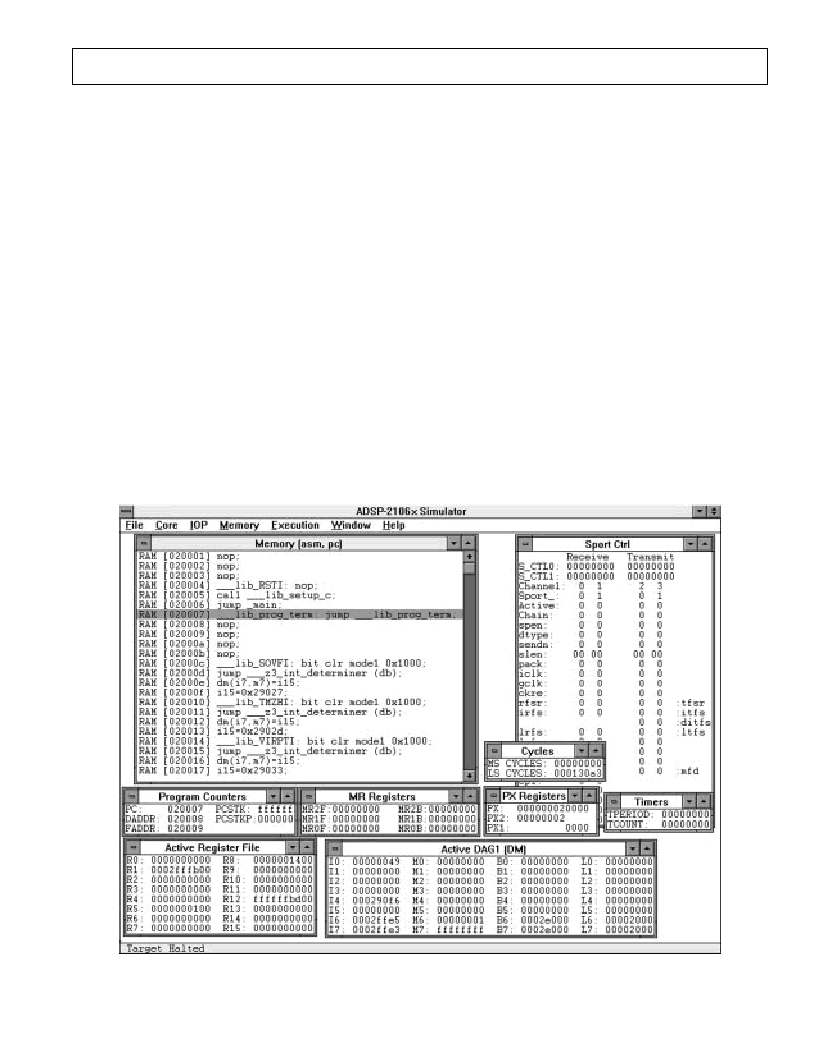- 您現(xiàn)在的位置:買賣IC網(wǎng) > PDF目錄362133 > ADDS-2106X-EZLITE DSP KIT PDF資料下載
參數(shù)資料
| 型號(hào): | ADDS-2106X-EZLITE |
| 英文描述: | DSP KIT |
| 中文描述: | DSP套件 |
| 文件頁數(shù): | 3/12頁 |
| 文件大小: | 154K |
| 代理商: | ADDS-2106X-EZLITE |

ADDS-210xx-TOOLS
REV. B
–3–
SOFT WARE T OOLS
Assembler
T he Assembler reads ADSP-21000 Family assembly language
source files and generates a relocatable object file. It includes
a preprocessor that lets you use the C preprocessor directives
#define
,
#include
,
#if
,
#ifdef
, and
#else
in assembly code.
Assembler directives define code modules, data buffers, data
variables, and memory mapped I/O ports. Both the assembler
and C preprocessor have directives to define macros.
Programming in assembly language is eased by the highly read-
able algebraic syntax of the ADSP-21000 Family instruction set.
An add instruction, for example, is written in the same manner
as the actual equation: T he algebraic statement r = x + y is
coded in assembly language as (f0 = f1 + f2).
Linker
T he Linker processes separately assembled object and library
files to create a single executable program. It assigns memory
locations to code and data according to user defined architecture
files—text files that describe the memory configuration of the
target system. T he Linker generates symbols (variable names
and program labels) in the processed files that are used by the
simulator and emulator to perform symbolic debugging.
Assembly Library/Librarian
T he Assembly Library contains standard arithmetic and DSP
routines accessible to your programs. You can create libraries of
your own functions using the Librarian tool.
Simulator
T he Simulator, a software model of the DSP, provides instruction-
level simulation of program execution. It models system
memory and I/O according to the contents of the system
architecture file, and displays hardware registers and memory
in separate data windows (see Figure 1). T he standard
Windows Graphical User Interface (GUI) provides additional
reconfigurable windows that display and let you alter register
and memory contents, making a powerful debugging
environment. T he Simulator also reads symbols to perform
symbolic debugging. A separate Simulator is provided for
ADSP-2106x class DSPs and for ADSP-21020 class DSPs.
Features of the ADSP-21000 Family Simulators:
Display of all registers, caches, and stacks
Integration with CBUG C Source-Level Debugger
Single step execution
Interrupt simulation
Plotting memory
Break points and break conditions
Simulation of program and data memory.
G21K ANSI C COMPILE R
K nown for its efficiency and reliability, the GNU-based
Optimizing G21K C Compiler supports in-line assembly code,
using the
asm
( ) construct, and generates COFF (Common
Object Format Files), an industry standard file format for
object, library, and executable files.
Figure 1. ADSP-21000 Family Simulator and Emulator User Interface
相關(guān)PDF資料 |
PDF描述 |
|---|---|
| ADDS-2181-EZLITE | EZ-KIT Lite for Analog Devices ADSP-218x DSP Family.(945.78 k) |
| ADDS2121 | Logic IC |
| ADDS2123C | Logic IC |
| ADDS2130 | Logic IC |
| ADDS2133C | Logic IC |
相關(guān)代理商/技術(shù)參數(shù) |
參數(shù)描述 |
|---|---|
| ADDS-2111-EZ-ICE | 制造商:AD 制造商全稱:Analog Devices 功能描述:ADSP-2100 Family Development Tools |
| ADDS-2111-EZ-KIT | 制造商:AD 制造商全稱:Analog Devices 功能描述:ADSP-2100 Family Development Tools |
| ADDS-2111-EZ-LAB | 制造商:AD 制造商全稱:Analog Devices 功能描述:ADSP-2100 Family Development Tools |
| ADDS-21160-EZLITE | 制造商:Analog Devices 功能描述:Development Tools For The Adsp-21160 Dsp |
| ADDS-21161N-EZLITE | 制造商:Analog Devices 功能描述:Evaluation Board For ADSP-21161N DSP |
發(fā)布緊急采購,3分鐘左右您將得到回復(fù)。